6.1 INTRODUCTION:
What Is Memory?

KEY THEME
Memory is a group of related mental processes that are involved in acquiring, storing, and retrieving information.
KEY QUESTIONS
What are encoding, storage, and retrieval?
What is the stage model of memory?
What are the nature and function of sensory memory?
Like Elizabeth’s memories of her uncle’s home, memories can be vivid and evoke intense emotions. We can conjure up distinct memories that involve all our senses, including smells, sounds, and even tactile sensations. For example, close your eyes and try to recall the feeling of rain-soaked clothes against your skin, the smell of popcorn, and the sound of the half-time buzzer during a high school basketball game.
Memory refers to the mental processes that enable us to acquire, retain, and retrieve information. Rather than being a single process, memory involves three fundamental processes: encoding, storage, and retrieval.
memory
The mental processes that enable you to retain and retrieve information over time.
Encoding refers to the process of transforming information into a form that can be entered and retained by the memory system. For example, to memorize the definition of a key term that appears on a textbook page, you would visually encode the patterns of lines and dots on the page as meaningful words that could be retained by your memory. Storage is the process of retaining information in memory so that it can be used at a later time. Retrieval involves recovering the stored information so that we are consciously aware of it.
encoding
The process of transforming information into a form that can be entered into and retained by the memory system.
storage
The process of retaining information in memory so that it can be used at a later time.
retrieval
The process of recovering information stored in memory so that we are consciously aware of it.
The Stage Model of Memory
No single model has been shown to capture all aspects of human memory (Baddeley & others, 2009; Tulving, 2007). However, one very influential model, the stage model of memory, is useful in explaining the basic workings of memory. In this model, shown in FIGURE 6.1, memory involves three distinct stages: sensory memory, short-term memory, and long-term memory (Atkinson & Shiffrin, 1968; Shiffrin & Atkinson, 1969). The stage model is based on the idea that information is transferred from one memory stage to another.

stage model of memory
A model describing memory as consisting of three distinct stages: sensory memory, short-term memory, and long-term memory.
The first stage of memory is called sensory memory. Sensory memory registers a great deal of information from the environment and holds it for a very brief period of time (Treisman & Lages, 2013). After three seconds or less, the information fades. Think of your sensory memory as an internal camera that continuously takes “snapshots” of your surroundings. With each snapshot, you momentarily focus your attention on specific details. Almost instantly, the snapshot fades, only to be replaced by another.
sensory memory
The stage of memory that registers information from the environment and holds it for a very brief period of time.
During the very brief time the information is held in sensory memory, you “select,” or pay attention to, just a few aspects of all the environmental information that’s being registered. While studying, for example, you focus your attention on one page of your textbook, ignoring other environmental stimuli. The information you select from sensory memory is important because this information is transferred to the second stage of memory, short-term memory.

Short-term memory refers to the active, working memory system. Your short-term memory temporarily holds all the information you are currently thinking about or consciously aware of. That information is stored briefly in short-term memory—for up to about 20 seconds. Because you use your short-term memory to actively process conscious information in a variety of ways, short-term memory is often referred to as working memory (Baddeley, 1995, 2007, 2010). Imagining, remembering, and conscious problem solving all take place in short-term memory.
short-term memory
The active stage of memory in which information is stored for up to about 20 seconds.
Over the course of any given day, vast amounts of information flow through your short-term memory. Most of this information quickly fades and is forgotten in a matter of seconds. However, some of the information that is actively processed in short-term memory may be encoded for storage in long-term memory.
Long-term memory, the third memory stage, represents what most people typically think of as memory—the long-term storage of information, potentially for a lifetime. It’s important to note that the transfer of information between short-term and long-term memory goes two ways. Not only does information flow from short-term memory to long-term memory, but much information also flows in the other direction, from long-term memory to short-term memory.
long-term memory
The stage of memory that represents the long-term storage of information.
If you think about it, this makes a great deal of sense. Consider a routine cognitive task, such as carrying on a conversation. Such tasks involve processing current sensory data and retrieving relevant stored information, such as the meaning of individual words. In the next few sections, we’ll describe each of the stages of memory in more detail.
Sensory Memory
FLEETING IMPRESSIONS OF THE WORLD
Has something like this ever happened to you? You’re engrossed in watching a suspenseful movie. From another room, a family member calls out, “Where’d you put my car keys?” You respond with, “What?” Then, a split second later, the question registers in your mind. Before the other person can repeat the question, you reply, “Oh. They’re on the kitchen counter.”
You were able to answer the question because your sensory memory registered and preserved the other person’s words for a few fleeting seconds—just long enough for you to recall what had been said to you while your attention was focused on the movie. Sensory memory stores a detailed record of a sensory experience, but only for a few seconds at the most.
THE DURATION OF SENSORY MEMORYIT WAS THERE JUST A SPLIT SECOND AGO!
The characteristics of visual sensory memory, also called iconic memory, were first identified largely through the research of psychologist George Sperling in 1960. In his experiment, Sperling flashed the images of 12 letters on a screen for one-twentieth of a second. The letters were arranged in four rows of 3 letters each. Subjects focused their attention on the screen and, immediately after the screen went blank, reported as many letters as they could remember.
On average, subjects could report only 4 or 5 of the 12 letters. However, several subjects claimed that they had actually seen all the letters but that the complete image had faded from their memory as they spoke, disappearing before they could verbally report more than 4 or 5 letters.
On the basis of this information, Sperling tried a simple variation on the original experiment (see FIGURE 6.2). He arranged the 12 letters in three rows of 4 letters each. Then, immediately after the screen went blank, he sounded a high-pitched, medium-pitched, or low-pitched tone. If the subjects heard the high-pitched tone, they were to report the letters in the top row; the medium-pitched tone signaled the middle row; and the low-pitched tone signaled the bottom row. If the subjects actually did see all the letters, Sperling reasoned, then they should be able to report the letters in a given row by focusing their attention on the indicated row before their visual sensory memory faded.

This is exactly what happened. If the tone followed the letter display in under one-third of a second, subjects could accurately report about 3 of the 4 letters in whichever row was indicated by the tone. However, if the interval between the screen going blank and the sound of the tone was more than one-third of a second, the accuracy of the reports decreased dramatically. By the time one second had elapsed, the image in the subject’s visual sensory memory had already faded beyond recall.
Sperling’s classic experiment demonstrated that our visual sensory memory holds a great deal of information very briefly, for about half a second. This information is available just long enough for us to pay attention to specific elements that are significant to us at that moment. This meaningful information is then transferred from the very brief storage of sensory memory to the somewhat longer storage of short-term memory.
TYPES OF SENSORY MEMORYPICK A SENSE, ANY SENSE!
Memory researchers believe there is a separate sensory memory for each sense—vision, hearing, touch, smell, and so on (Werkhoven & Erp, 2013). Of the different senses, however, visual and auditory sensory memories have been the most thoroughly studied. Visual sensory memory is sometimes referred to as iconic memory because it is the brief memory of an image, or icon. Auditory sensory memory is sometimes referred to as echoic memory, meaning a brief memory that is like an echo.
Researchers have found slight differences in the duration of sensory memory for visual and auditory information. Your visual sensory memory typically holds an image of your environment for about one-quarter to one-half second before it is replaced by yet another overlapping “snapshot.” This is easy to demonstrate. Quickly wave a pencil back and forth in front of your face. Do you see the fading image of the pencil trailing behind it? That’s your visual sensory memory at work. It momentarily holds the snapshot of the environmental image you see before it is almost instantly replaced by another overlapping image.
Your auditory sensory memory holds sound information a little longer, up to three or four seconds. This brief auditory sensory trace for sound allows you to hear speech as continuous words, or a series of musical notes as a melody, rather than as disjointed sounds. It also explains why you are able to “remember” something that you momentarily don’t “hear,” as in the example of the family member asking you where the car keys were.
An important function of sensory memory is to very briefly store sensory impressions so that they overlap slightly with one another. Thus, we perceive the world around us as continuous, rather than as a series of disconnected visual images or disjointed sounds.
Short-Term, Working Memory
THE WORKSHOP OF CONSCIOUSNESS
KEY THEME
Short-term memory provides temporary storage for information transferred from sensory and long-term memory.
KEY QUESTIONS
What are the duration and capacity of short-term memory?
How can you overcome the limitations of short-term memory?
What are the main components of Baddeley’s model of working memory?
You can think of short-term memory, or working memory, as the “workshop” of consciousness. It is the stage of memory in which information transferred from sensory memory and information retrieved from long-term memory become conscious. When you recall a past event or mentally add two numbers, the information is temporarily held and processed in your short-term memory. Your short-term memory also allows you to make sense out of this sentence by holding the beginning of the sentence in active memory while you read the rest of the sentence. Thus, short-term, working memory provides temporary storage for information that is currently being used in some conscious cognitive activity.

THE DURATION OF SHORT-TERM MEMORYGOING, GOING, GONE!
Information in short-term memory lasts longer than information in sensory memory, but its duration is still very short. Estimates vary, but generally you can hold most types of information in short-term memory up to about 20 seconds before it’s forgotten (Peterson & Peterson, 1959). However, information can be maintained in short-term memory if it is rehearsed, or repeated, over and over. Because consciously rehearsing information will maintain it in short-term memory, this process is called maintenance rehearsal. For example, suppose that you decide to order a pizza for yourself and some friends. You look up the number and mentally rehearse it until you can dial the phone.
maintenance rehearsal
The mental or verbal repetition of information in order to maintain it beyond the usual 20-second duration of short-term memory.
Information that is not actively rehearsed is rapidly lost. Why? One possible explanation is that information that is not maintained by rehearsal simply fades away, or decays, with the passage of time. Another potential cause of forgetting in short-term memory is interference from new or competing information (Baddeley, 2002; Nairne, 2002). For example, if you are distracted by one of your friends asking you a question before you dial the pizza place, your memory of the phone number will quickly evaporate. Interference may also explain the irritating experience of forgetting someone’s name just moments after you’re introduced to him or her. If you engage the new acquaintance in conversation without rehearsing his or her name, the conversation may “bump” the person’s name out of your short-term memory.
THE CAPACITY OF SHORT-TERM MEMORYSO THAT’S WHY THERE WERE SEVEN DWARFS!
Along with having a relatively short duration, short-term memory also has a relatively limited capacity. This is easy to demonstrate. Take a look at the numbers in the margin. If you’ve got a friend handy who’s willing to serve as your research subject, simply read the numbers out loud, one row at a time, and ask your friend to repeat them back to you in the same order. Try to read the numbers at a steady rate, about one per second. Note each row that he correctly remembers.
How many numbers could your friend repeat accurately? Most likely, he could correctly repeat between five and nine numbers. That’s what psychologist George Miller (1956) described as the limits of short-term memory in a classic paper titled “The Magical Number Seven, Plus or Minus Two.” Miller believed that the capacity of short-term memory is limited to about seven items, or bits of information, at one time. It’s no accident that local telephone numbers are seven digits long (Cowan & others, 2004).
So what happens when your short-term memory store is filled to capacity? New information displaces, or bumps out, currently held information. Maintenance rehearsal is one way to avoid the loss of information from short-term memory. By consciously repeating the information you want to remember, you keep it active in short-term memory and prevent it from being displaced by new information.
Although the capacity of your short-term memory is limited, there are ways to increase the amount of information you can hold in short-term memory at any given moment. To illustrate this point, let’s try another short-term memory demonstration. Read the sequence of letters in the margin, then close your eyes and try to repeat the letters out loud in the same order.
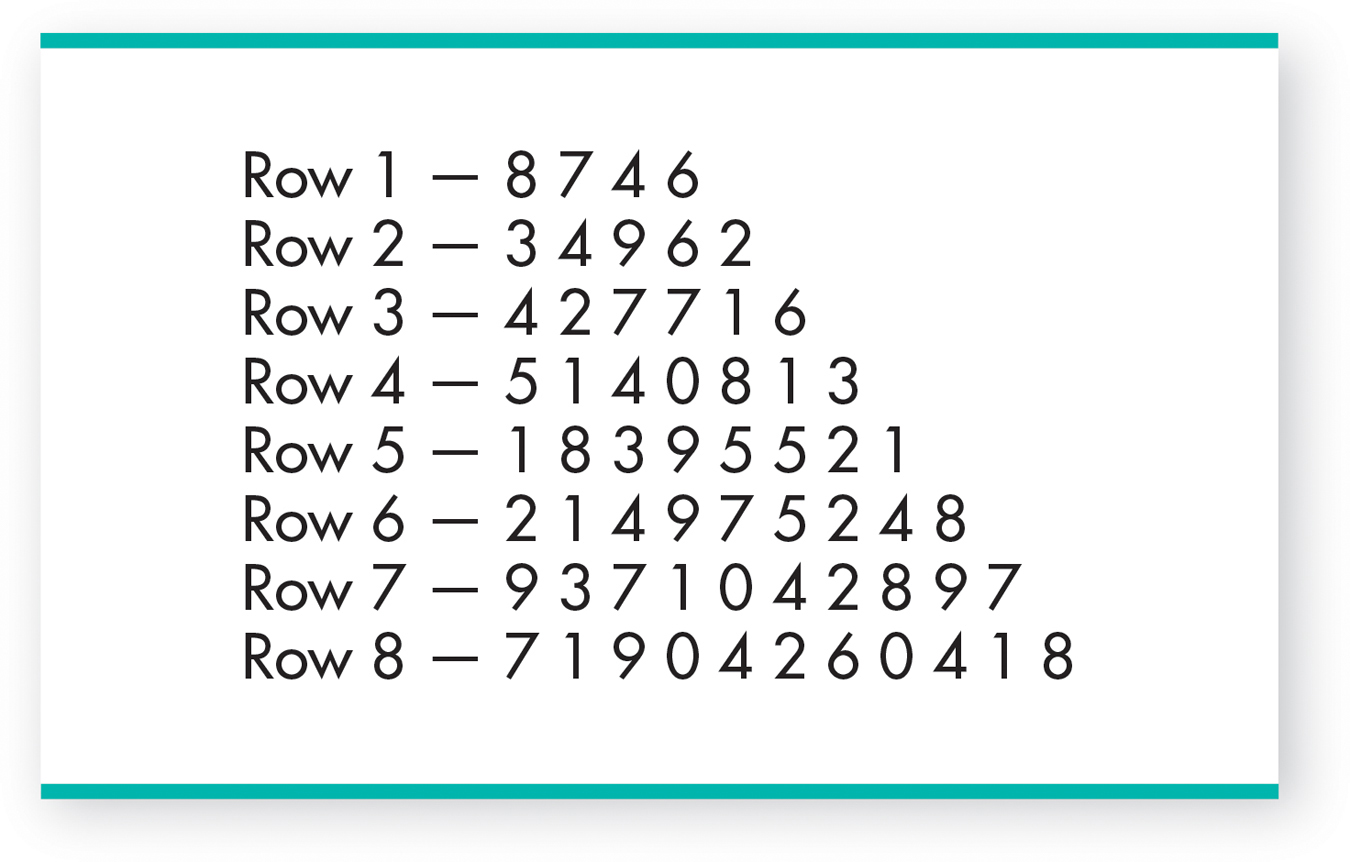
How many letters were you able to remember? Unless you have an exceptional short-term memory, you probably could not repeat the whole sequence correctly. Now try this sequence of letters: D V D F B I U S A C I A.

You probably managed the second sequence with no trouble at all, even though it is made up of exactly the same letters as the first sequence. The ease with which you handled the second sequence demonstrates chunking—the grouping of related items together into a single unit. The first letter sequence was perceived as 12 separate items and probably exceeded your short-term memory’s capacity. But the second letter sequence was perceived as only four “chunks” of information, which you easily remembered: DVD, FBI, USA, and CIA. Thus, chunking can increase the amount of information held in short-term memory. But to do so, chunking also often involves the retrieval of meaningful information from long-term memory, such as the meaning of the initials FBI (Baddeley & others, 2010).
chunking
Increasing the amount of information that can be held in short-term memory by grouping related items together into a single unit, or chunk.
The basic principle of chunking is incorporated into many numbers that we need to remember. Long strings of identification numbers, such as Social Security numbers or credit card numbers, are usually broken up by hyphens or spaces so that you can chunk them easily.
Not every memory researcher accepts that short-term memory is limited to exactly seven items, plus or minus two. Over the half-century since the publication of Miller’s classic article, researchers have challenged the seven-item limit (Cowan & others, 2007; Jonides & others, 2008). Current research suggests that the true “magical number” is more likely to be four plus or minus one rather than seven plus or minus two (Cowan & others, 2007; Cowan, 2010).
Cognitive psychologist Nelson Cowan (2001, 2005, 2010) believes that the type of stimuli used in many short-term memory tests has led researchers to overestimate its capacity. Typically, such memory tests use lists of letters, numbers, or words. According to Cowan, many people automatically chunk such stimuli to help remember them. For example, even seemingly random numbers may be easily associated with a date, an address, or another familiar number sequence.
To overcome this tendency, Jeffrey Rouder and his colleagues (2008) used a simple visual stimulus instead of a sequence of numbers, letters, or words. The memory task? Remembering the position of colored squares on a computer screen. In this and similar studies, participants were able to hold only three or four items in their short-term memory at a time. Thus, most researchers today believe that the capacity of working memory is no more than about three to four items at a time when chunking is not an option (Cowan, 2010; Mandler, 2013).
Whether the “magic number” is four or seven, the point remains: Short-term memory has a limited number of mental “slots” for information. Chunking can increase the amount of information held in each slot, but the number of slots is still limited.
FROM SHORT-TERM MEMORY TO WORKING MEMORY
Our discussion of the short-term memory store has so far focused on just one type of information—verbal or acoustic codes, that is, speech-like stimuli that we can mentally recite. Lists of numbers, letters, words, or other items fall into this category. However, if you think about it, we also use our short-term memory to temporarily store and manipulate other types of stimuli, such as visual images. For example, suppose you’re out shopping with a close friend who asks you whether you think a particular chair will match her living room furniture. Before you respond, you need to call up and hold a mental image of her living room. You are surely using your short-term memory as you consider her question, but how?
In this example, you are actively processing information in a short-term memory system that is often referred to as working memory. Although the terms working memory and short-term memory are sometimes used interchangeably, working memory refers to the active, conscious manipulation of temporarily stored information. You use your working memory when you engage in problem solving, reasoning, language comprehension, and mental comparisons. Short-term memory is more likely to be used when the focus is on simpler memory processes, such as rehearsing lists of syllables, words, or numbers (Baddeley, 2010). And, in contrast to short-term memory, working memory is more likely to involve the recall and manipulation of information held in long-term memory (Corkin, 2013).
working memory
The temporary storage and active, conscious manipulation of information needed for complex cognitive tasks, such as reasoning, learning, and problem solving.
The best-known model of working memory was developed by British psychologist Alan Baddeley. In Baddeley’s (1992, 2007) model of working memory, there are three main components, each of which can function independently (see FIGURE 6.3). One component, called the phonological loop, is specialized for verbal material, such as lists of numbers or words. This is the aspect of working memory that is often tested by standard memory tasks (Mueller & others, 2003). The second component, called the visuospatial sketchpad, is specialized for spatial or visual material, such as remembering the layout of a room or city.
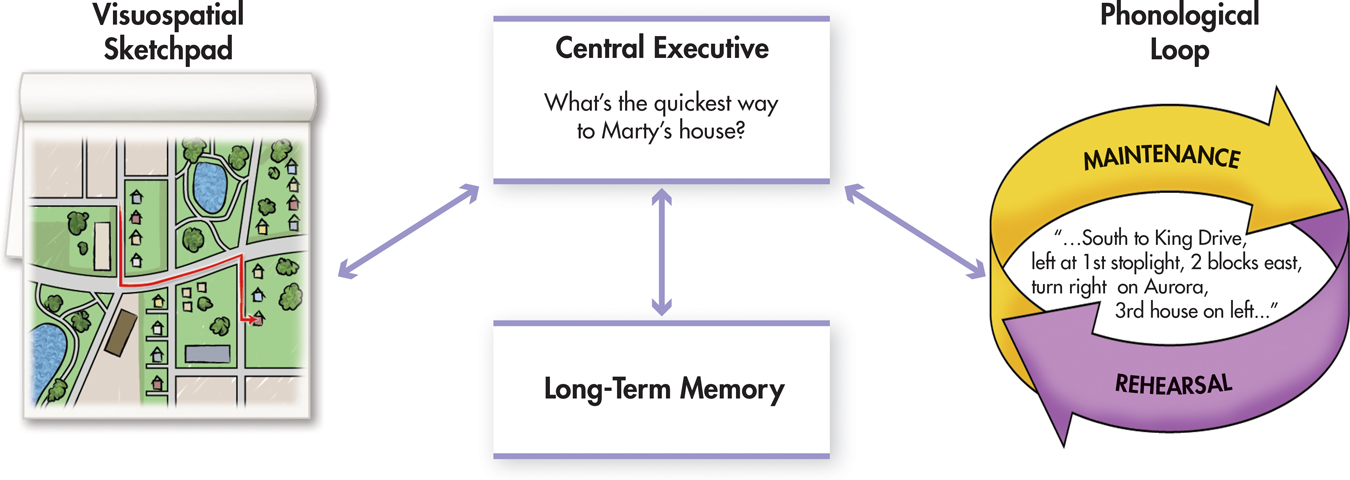
The third component is what Baddeley calls the central executive, which controls attention, integrates information, and manages the activities of the phonological loop and the visuospatial sketchpad. The central executive also initiates retrieval and decision processes as necessary and integrates information coming into the system.
Long-Term Memory
KEY THEME
Once encoded, an unlimited amount of information can be stored in long-term memory, which has different memory systems.
KEY QUESTIONS
What are ways to improve the effectiveness of encoding?
How do procedural, episodic, and semantic memories differ, and what are implicit and explicit memory?
How does the semantic network model explain the organization of long-term memory?
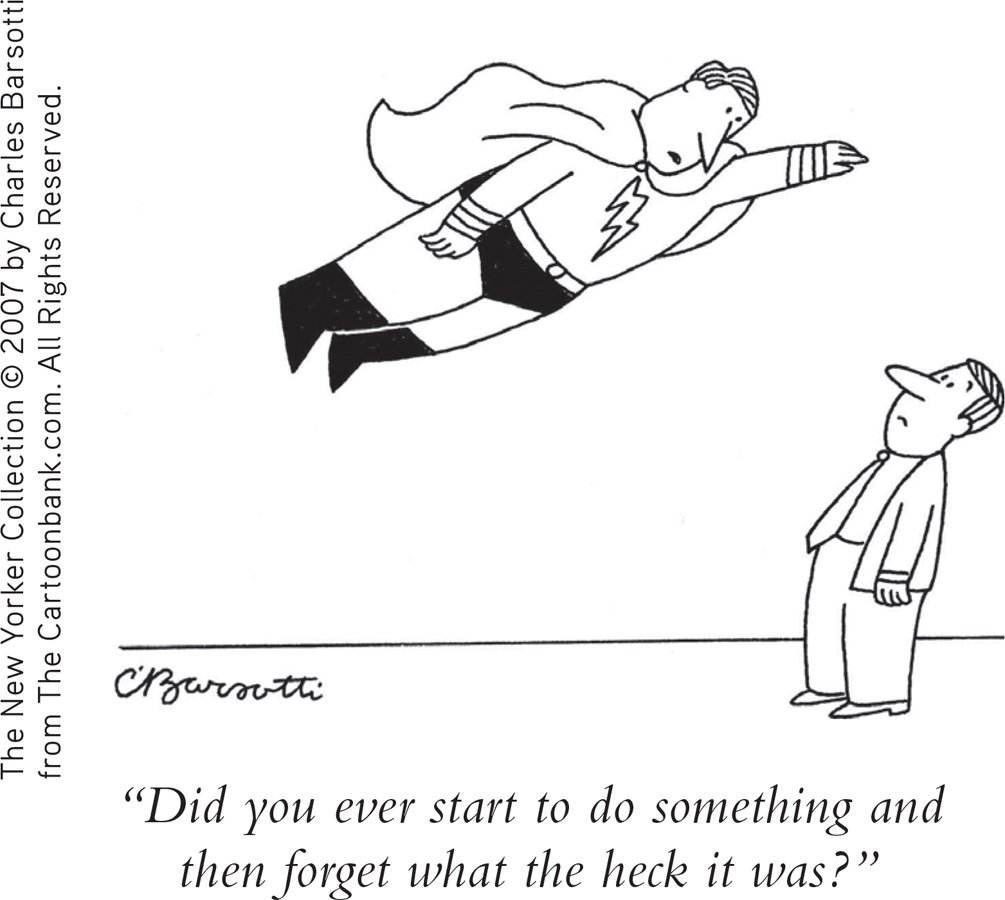
Long-term memory refers to the storage of information over extended periods of time. Technically, any information stored longer than the roughly 20-second duration of short-term memory is considered to be stored in long-term memory. In terms of maximum duration, some long-term memories last a lifetime.
In contrast to the limited capacities of sensory and short-term memory, the amount of information that can be held in long-term memory is limitless. Granted, it doesn’t always feel limitless, but consider this: Every day, you remember the directions to your college; the names of hundreds of friends, relatives, and acquaintances; and how to start your car. Retrieving information from long-term memory happens quickly and with little effort—most of the time.
ENCODING LONG-TERM MEMORIES
How does information get “into” long-term memory? One very important function that takes place in short-term memory is encoding, or transforming the new information into a form that can be retrieved later (see FIGURE 6.4). As a student, you may have tried to memorize dates, facts, or definitions by simply repeating them to yourself over and over. This strategy reflects an attempt to use maintenance rehearsal to encode material into long-term memory. However, maintenance rehearsal is not a very effective strategy for encoding information into long-term memory.
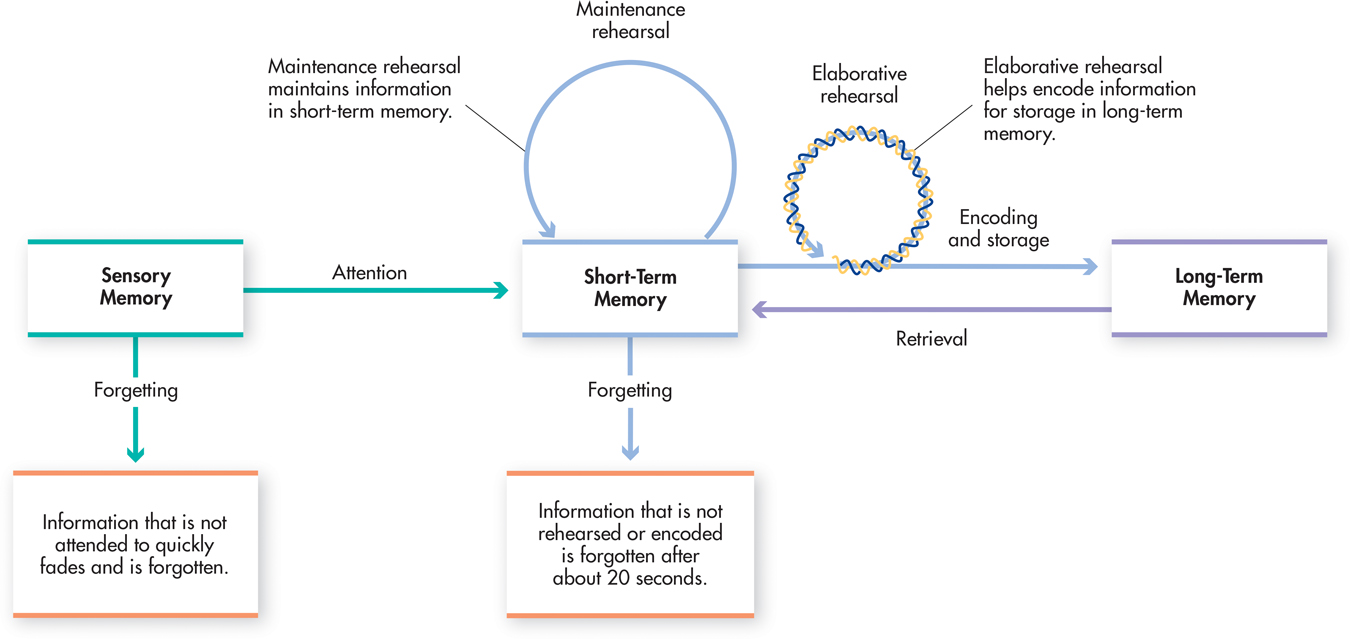
A much more effective encoding strategy is elaborative rehearsal, which involves focusing on the meaning of information to help encode and transfer it to long-term memory. With elaborative rehearsal, you relate the information to other information you already know. That is, rather than simply repeating the information, you elaborate on the new information in some meaningful way.
elaborative rehearsal
Rehearsal that involves focusing on the meaning of information to help encode and transfer it to long-term memory.
Elaborative rehearsal significantly improves memory for new material. This point is especially important for students, because elaborative rehearsal is a helpful study strategy. Here’s an example of how you might use elaborative rehearsal to improve your memory for new information. In Chapter 2 we discussed three brain structures that are part of the limbic system: the hypothalamus, the hippocampus, and the amygdala. If you tried to memorize the definitions of these structures by reciting them over and over to yourself, you engaged in the not-so-effective memory strategy of maintenance rehearsal.
But if you elaborated on the information in some meaningful way, you would be more likely to recall it. For example, you could think about the limbic system’s involvement in emotions, memory, and motivation by constructing a simple story. “I knew it was lunchtime because my hypothalamus told me I was hungry, thirsty, and cold. My hippocampus helped me remember a new restaurant that opened on campus, but when I got there I had to wait in line and my amygdala reacted with anger.” The story may be a bit silly, but many studies have shown that elaborative rehearsal leads to better retention (Lockhart & Craik, 1990).
Creating this simple story to help you remember the limbic system illustrates two additional factors that enhance encoding. First, applying information to yourself, called the self-reference effect, improves your memory for information. Second, the use of visual imagery, especially vivid images, also enhances encoding (Kesebir & Oishi, 2010; Paivio, 2007).
The fact that elaborative rehearsal results in more effective encoding and better memory of new information has many practical applications for students. As you study:
Make sure you understand the new information by restating it in your own words.
Actively question new information.
Think about the potential applications and implications of the material.
Relate the new material to information you already know, searching for connections that make the new information more meaningful.
Generate your own examples of the concept, especially examples from your own experiences.
At the end of the chapter, in Psych for Your Life, we’ll give you more suggestions for strategies you can use to improve your memory.

TYPES OF INFORMATION IN LONG-TERM MEMORY
There are three major categories of information stored in long-term memory (Tulving, 1985, 2002). Procedural memory refers to the long-term memory of how to perform different skills, operations, and actions. Typing, riding a bike, running, and making scrambled eggs are all examples of procedural information stored in long-term memory. We begin forming procedural memories early in life when we learn to walk, talk, feed ourselves, and so on.
procedural memory
Category of long-term memory that includes memories of different skills, operations, and actions.
Often, we can’t recall exactly when or how we learned procedural information. And usually it’s difficult to describe procedural memories in words. For example, try to describe precisely and exactly what you do when you blow-dry your hair, play the guitar, or ride a bicycle. A particular skill may be easy to demonstrate but very difficult to describe.
In contrast to procedural memory, episodic memory refers to your long-term memory of specific events or episodes, including the time and place that they occurred (Gallo & Wheeler, 2013; Tulving, 2002). Your memory of attending a friend’s wedding or your first day at college would both be examples of episodic memories.
episodic memory
Category of long-term memory that includes memories of particular events.
The third category of long-term memory is semantic memory—general knowledge that includes facts, names, definitions, concepts, and ideas. Semantic memory represents your personal encyclopedia of accumulated data and trivia stored in your long-term memory. Typically, you store semantic memories in long-term memory without remembering when or where you originally acquired the information. For example, can you remember when or where you learned that there are different time zones across the United States? Or when you learned that there are nine innings in a baseball game?
semantic memory
Category of long-term memory that includes memories of general knowledge, concepts, facts, and names.
Closely related to episodic memory is autobiographical memory, which refers to the events of your life—your personal life history (Fivush, 2011). Your autobiographical memory includes your episodic memories about your life. But it also includes the semantic memories that relate to your life story, such as knowing when and where your parents met or when and where you were born (Tulving & Szpunar, 2009). Autobiographical memory plays a key role in your sense of self (Ross & Wang, 2010). Does culture affect autobiographical memory? In the Culture and Human Behavior box, we examine the impact of culture on people’s earliest memories.
IMPLICIT AND EXPLICIT MEMORYTWO DIMENSIONS OF LONG-TERM MEMORY
Studies with patients who have suffered different types of amnesia as a result of damage to particular brain areas have led memory researchers to recognize that long-term memory is not a simple, unitary system. Instead, long-term memory appears to be composed of separate but interacting subsystems and abilities (Slotnick & Schacter, 2007).
What are these subsystems? One basic distinction that has been made is between explicit memory and implicit memory. Explicit memory is memory with awareness—information or knowledge that can be consciously recollected, including episodic and semantic information. Thus, remembering what you did last New Year’s Day or the topics discussed in your last psychology class are both examples of explicit memory. Explicit memories are also called declarative memories because, if asked, you can “declare” the information.
explicit memory
Information or knowledge that can be consciously recollected; also called declarative memory.
In contrast, implicit memory is memory without awareness. Implicit memories cannot be consciously recollected, but they still affect your behavior, knowledge, or performance of some task. For example, let’s assume that you are a pretty good typist. Imagine that we asked you to type the following phrase with your eyes closed: “most zebras cannot be extravagant.” Easy, right? Now, without looking at a typewriter or computer keyboard, try reciting, from left to right, the seven letters of the alphabet that appear on the bottom row of a keyboard. Can you do it? Your authors are both expert typists, and neither one of us could do this. Chances are, you can’t either. (In case you’re wondering, the letters are ZXCVBNM.)
implicit memory
Information or knowledge that affects behavior or task performance but cannot be consciously recollected; also called non-declarative memory.
Here’s the point: Your ability to type the phrase “most zebras cannot be extravagant” without looking demonstrates that you do know the location of the letters Z, X, C, V, B, N, and M. But your inability to recite that knowledge demonstrates that your memory of each key’s location cannot be consciously recollected. Even though you’re not consciously aware of the memory, it still affects your behavior. Implicit memories are also called nondeclarative memories because you’re unable to “declare” the information. Procedural memories, including skills and habits, typically reflect implicit memory processes. FIGURE 6.5 summarizes the different types of long-term memory.
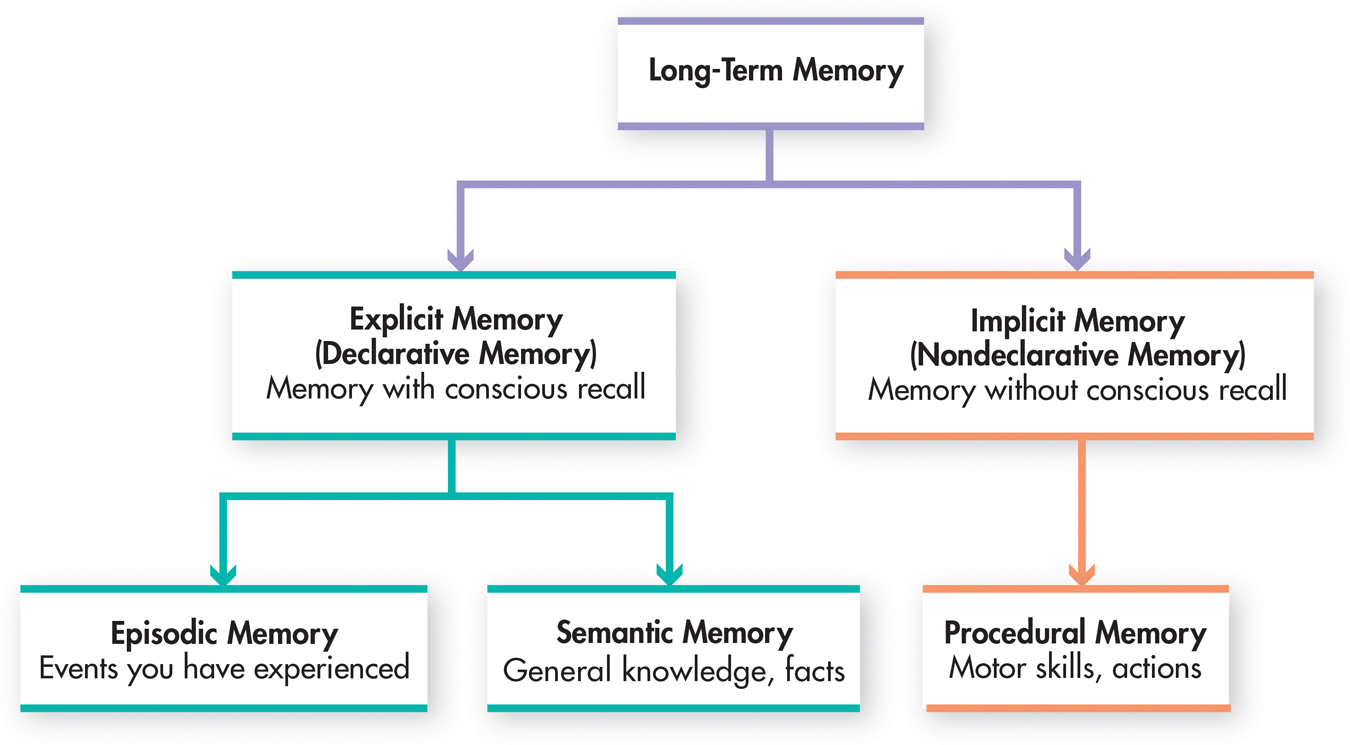
CULTURE AND HUMAN BEHAVIOR
Culture’s Effects on Early Memories
For most adults, earliest memories are for events that occurred between the ages of 2 and 4. These early memories mark the beginning of autobiographical memory, which provides the basis for the development of an enduring sense of self (Fivush, 2011; Markowitsch & Staniloiu, 2011). Do cultural differences in the sense of self influence the content of our earliest memories?
Comparing the earliest memories of European American college students and Taiwanese and Chinese college students, developmental psychologist Qi (pronounced “chee”) Wang (2001, 2006) found a number of significant differences. First, the average age for earliest memory was much earlier for the U.S.-born students than for the Taiwanese and Chinese students.

Wang also found that the Americans’ memories were more likely to be discrete, one-point-in-time events reflecting individual experiences or feelings, such as “I remember getting stung by a bee when I was 3 years old. I was scared and started crying.” In contrast, the earliest memories of both the Chinese and Taiwanese students were of general, routine activities with family, schoolmates, or community members, such as playing in the park or eating with family members.
For Americans, Wang notes, the past is like a drama in which the self plays the lead role. Themes of self-awareness and individual autonomy were more common in the American students’ memories, which tended to focus on their own experiences, emotions, and thoughts.
In contrast, Chinese students were more likely to include other people in their memories. Rather than focusing exclusively on their own behavior and thoughts, their earliest memories were typically brief accounts that centered on collective activities. For the Chinese students, the self is not easily separated from its social context.
Wang (2013) believes that cultural differences in autobiographical memory are formed in very early childhood, through interaction with family members. For example, shared reminiscing—the way that mothers talk to their children about their past experiences—differs in Eastern and Western cultures (Fivush, 2011). When Asian mothers reminisce with their children, they tend to talk about group settings or situations, and to de-emphasize emotions, such as anger, that might separate the child from the group. In comparison, Western mothers tend to focus more on the child’s individual activities, accomplishments, and emotional reactions (Ross & Wang, 2010). As Katherine Nelson and Robyn Fivush (2004) observe, such conversations about the personal past “provide children with information about how to be a ‘self’ in their culture.”
Although much of the memory research covered in this chapter centers on explicit memory, psychologists and neuroscientists have become increasingly interested in implicit memory. As we’ll see in a later section, there is growing evidence that implicit memory and explicit memory involve different brain regions (Eichenbaum, 2009; Thompson, 2005). Some memory theorists believe that implicit memory and explicit memory are two distinct memory systems (Kihlstrom & others, 2007; Tulving, 2002).
THE ORGANIZATION OF INFORMATION IN LONG-TERM MEMORY
Exactly how information is organized in long-term memory is not completely understood by memory researchers. Nonetheless, memory researchers know that information in long-term memory is clustered and associated.
Clustering means organizing items into related groups, or clusters, during recall. Before reading further, try the demonstration in FIGURE 6.6. Even though the words are presented in random order, you probably recalled groups of vehicles, fruits, and furniture. In other words, you organized the bits of information by clustering them into related categories.
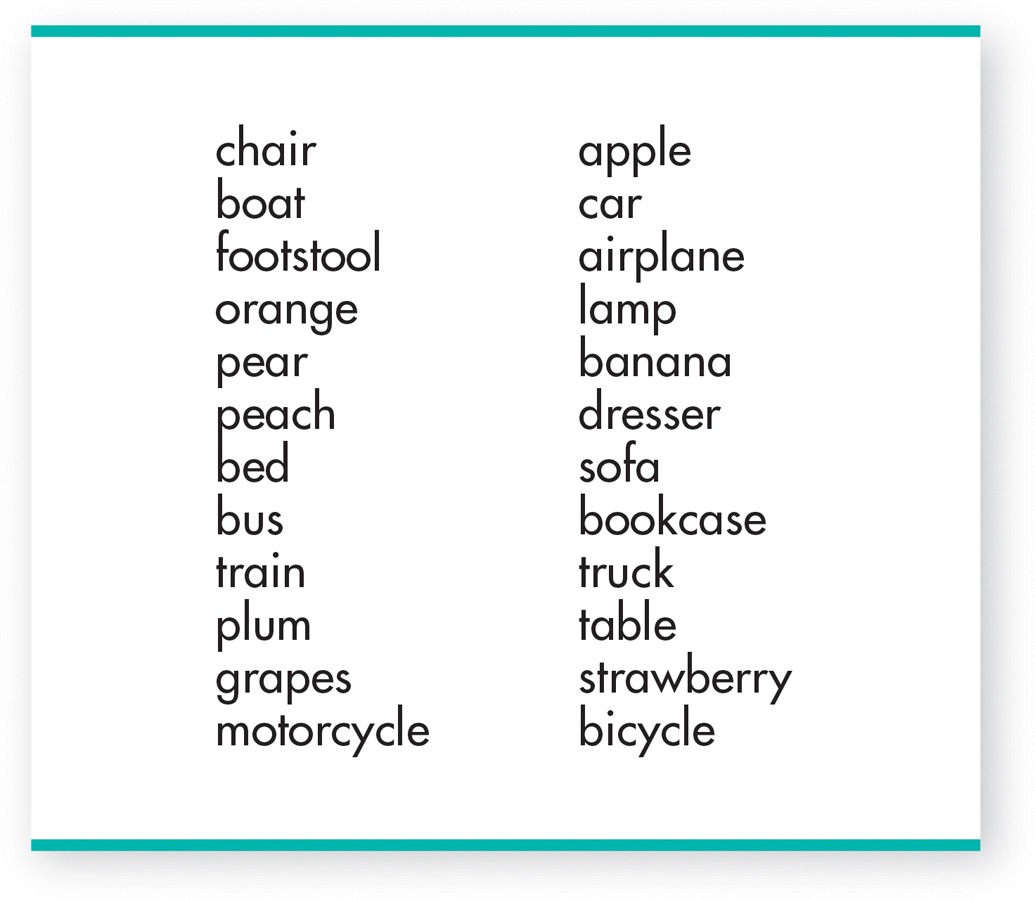
clustering
Organizing items into related groups during recall from long-term memory.
Different bits and pieces of information in long-term memory are also logically linked, or associated. For example, what’s the first word that comes to your mind in response to the word red? When we asked our students that same question, their top five responses were “blue,” “apple,” “color,” “green,” and “rose.” Even if you didn’t answer with one of the same associations, your response was based on some kind of logical association that you could explain if asked.
Memory researchers have developed several models to show how information is organized in long-term memory. One of the best-known models is called the semantic network model (Collins & Loftus, 1975). When one concept is activated in the semantic network, it can spread in any number of directions, activating other associations in the semantic network. For example, the word red might activate “blue” (another color), “apple,” “fire truck” (objects that are red), or “alert” (as in the phrase, “red alert”). In turn, these associations can activate other concepts in the network.
semantic network model
A model that describes units of information in long-term memory as being organized in a complex network of associations.
The semantic network model is a useful way of conceptualizing how information is organized in long-term memory. However, keep in mind that it is just a metaphor, not a physical structure in the brain. Nevertheless, the fact that information is organized in long-term memory has important implications for the retrieval process, as you’ll see in the next section.
CONCEPT REVIEW 6.1
Comparing the Three Stages of Memory
Identify each of the following descriptions as characteristic of sensory memory (SM), short-term memory (STM), or long-term memory (LTM).
Function
Question 6.1
| 1. | Storage of information for later retrieval |
Question 6.2
| 2. | Brief storage of sensory impressions |
Question 6.3
| 3. | Temporary storage of new information; interaction with stored information |
Duration
Question 6.4
| 4. | Potentially permanent |
Question 6.5
| 5. | Approximately 20 seconds |
Question 6.6
| 6. | Approximately 1/2 to 3 seconds |
Capacity
Question 6.7
| 7. | Limited capacity of about seven items |
Question 6.8
| 8. | Large but fleeting capacity |
Question 6.9
| 9. | Unlimited capacity |
Test your understanding of What Is Memory? with
 .
.